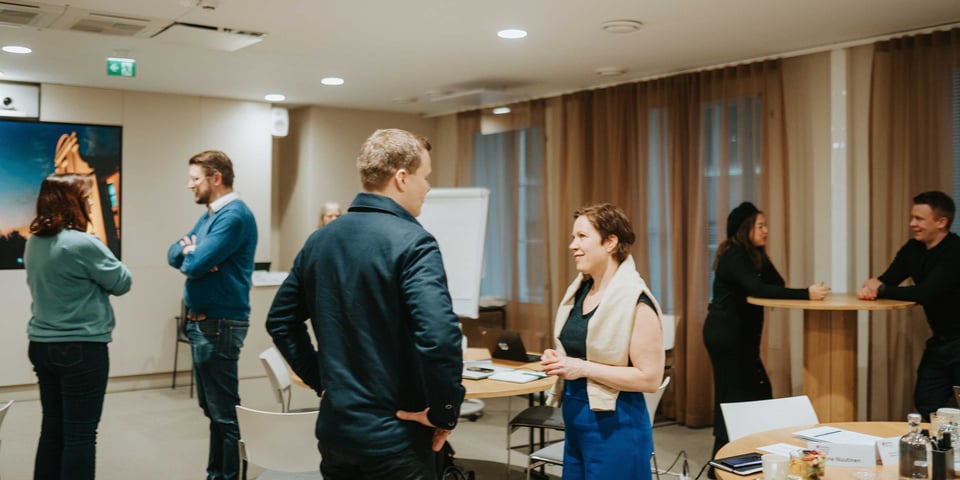What Happens When You Get Non-Verbal Feedback from Horses Instead of Human Colleagues?
Through our corporate solutions, we offer organisations tailored programmes, consulting, and coaching services—each built around one or more of our core pillars. Moreover, when opting for the development programmes, customers have a wide range of methods to choose from. All companies have different strategies, visions and needs, but without a method catalogue, it can be challenging to identify what kind of programmes we offer and how we can support them.
If you’re looking for a leadership development programme, I bet working with horses isn’t the first thing that comes to mind. Since it’s one of our most beloved methods, we’ll share in this blog what this unique approach involves.
Objectives
We have now delivered a leadership programme involving horses, for one of our corporate clients, three times in a row. The core themes of the programme have been psychological safety, emotional intelligence and trust, with the objective of supporting leaders in developing essential human-centred leadership capabilities, such as:
- Fostering psychological safety within their teams
- Strengthening emotional intelligence and awareness of team well-being
- Building trust-based working environments
- Understanding the underlying drivers of engagement and deepening commitment
In summary, the aim of the programme was to build psychologically safe teams, enhance emotional intelligence, and explore the drivers of engagement more deeply.
Equine Facilitating as a ‘Secret Sauce’ to Successful Learning
To meet these goals, we put together the programme with the help of our faculty member, Dr Sue Binks. Dr Binks is an Occupational Psychologist, Chartered Psychologist, and qualified coach with a doctorate in leadership development. Moreover, she is an equine (horse) facilitator and has used horses as her leadership training assistants for over 15 years. She even wakes up early every morning to feed her own horses.
What is an equine facilitator?
An equine facilitator is a professional who guides individuals or groups through activities with horses to support personal growth, leadership development, or therapeutic goals. This doesn’t involve horseback riding, but it’s more about being in the presence of horses, observing them, and becoming part of their herd.

Dr Sue Binks at the beginning of the session.
Leading with Presence
The programme placed strong emphasis on experiential and participatory methods. Leading with presence was at the core of everything.
To prepare for working with the horses, the programme included masterclasses on neuroscience. The key questions addressed were: What is psychological safety? How do you maintain it? And how can stress be managed from a neuroscience perspective?
These online sessions were delivered by Patricia Riddell, a Professor of Applied Neuroscience who specialises in applying neuroscience to the business world — essentially, what happens in your brain when you feel what you feel. She always brings a rich mix of academic insight and practical exercises to the table.
Embodied Learning
Finally, it was time to put the lessons into action during the residential module of the programme at Henley-on-Thames, and here’s where the horses came into the picture.
You may know that experiential learning often includes roleplay with fellow participants. While not new in leadership development, such methods typically involve socially filtered feedback, which is usually polished to be socially acceptable. Horses, on the other hand, as co-participants bring the next generation of experiential learning: embodied learning. There are no filters or social rules, only instant, honest feedback.
Horses sense how you carry yourself. They pick up micro body language cues and respond to who you are as a leader, not who you think you are. That’s the key difference between doing leadership and being a leader.
When humans join their herd, horses become keenly aware of their emotional state. If you’re insecure, anxious or avoidant, they won’t follow your lead. But if you demonstrate that you’re mentally and physically in charge, they’ll feel secure and be willing to follow your guidance. That’s exactly what happens in real-world corporate life, too.
This method teaches leaders to lead with presence by using head, heart and core as an integrated whole. It offers a rare opportunity to work with real-time emotional data and build the self-awareness that allows leaders to be more grounded and compassionate. This awareness is the foundation of advanced emotional intelligence—identified as the greatest growth barrier in a recent study on Finnish companies: Tutkimus: Suomalaisyritysten suurin kasvueste on tunnetaitojen puute | Kauppalehti (“Study: The greatest challenge stalling Finnish companies’ growth is the lack of emotional intelligence | Kauppalehti”)

A horse searching for new herd members in Checkendon Equestrian Centre, Henley-on-Thames
Insights and Impact
Throughout the programme, participants gained deep personal insights and made clear connections between self-awareness and leadership. One participant reflected:
“Very interactive, unique experience working with the horses which conveyed the learning in a much different way. Good amount of conceptual content vs discussion and doing.”
Our post-programme impact evaluation results were very positive. Participants rated various outcomes using a 7-point scale (1 = strongly disagree, 7 = strongly agree). The means are for example:
- I am now better able to create an environment in which others feel safe enough to offer ideas and suggestions: 6/7
- I am better able to create an environment in which others feel safe enough to admit mistakes: 5.9/7
- I think my team is satisfied with the attention I pay to their well-being: 6/7
- I help my team feel engaged at work: 5.8/7
In open-ended feedback, one participant described positive changes in her management style:
“The direct feedback and conversations I had with my peers and direct reports after Henley, and the things I noticed I need to work on—for example, the pace I move at—have helped me become more intentional about asking more questions and making it clear to others that I am aware and engaged.”
These reflections show how the programme’s impact goes beyond leadership techniques—it reshapes how participants relate to others, both at work and in life.
If you’re ready to take the next step on your journey to becoming a more present leader, you might consider working with four-legged colleagues.
Read more about our corporate solutions here.










